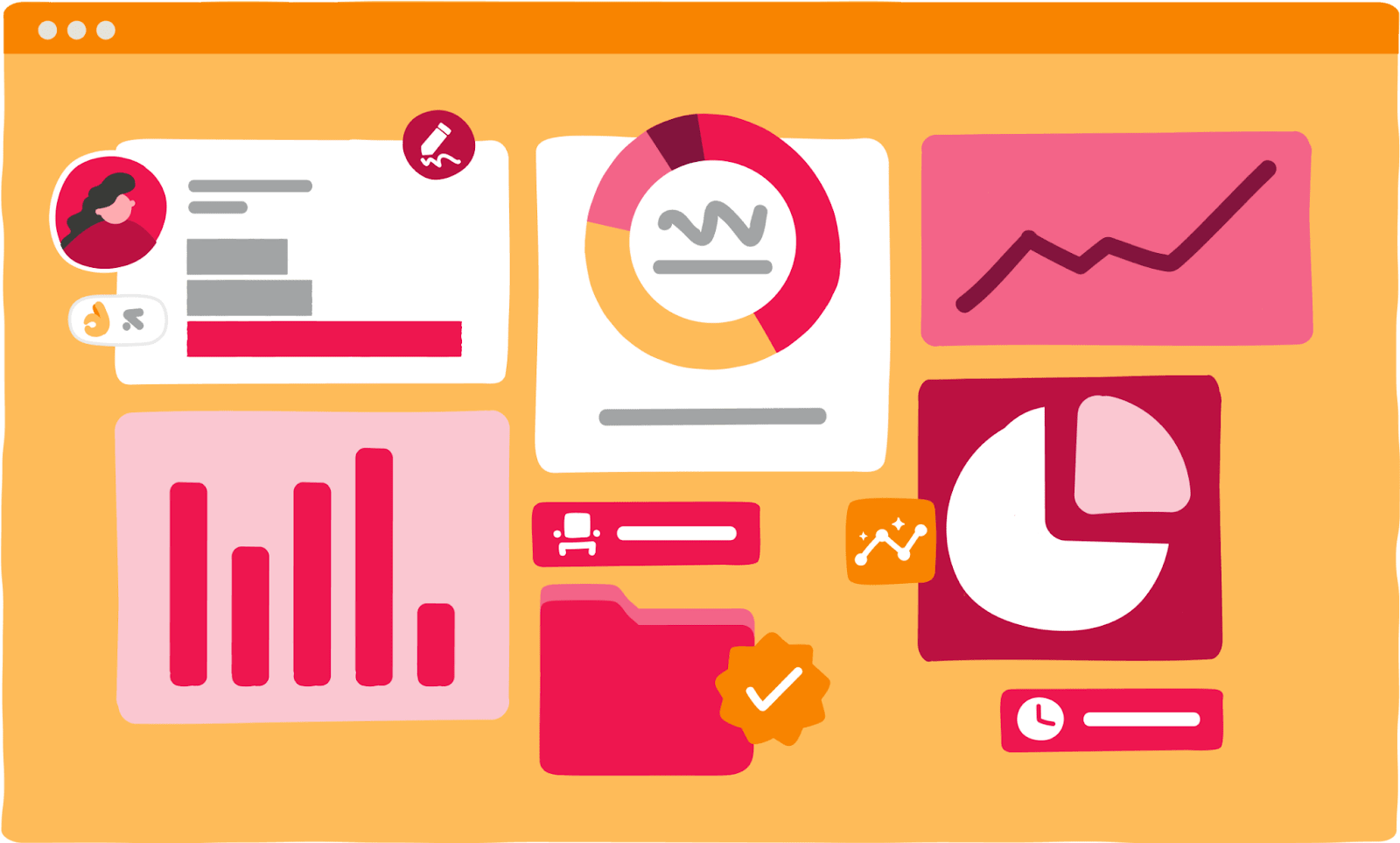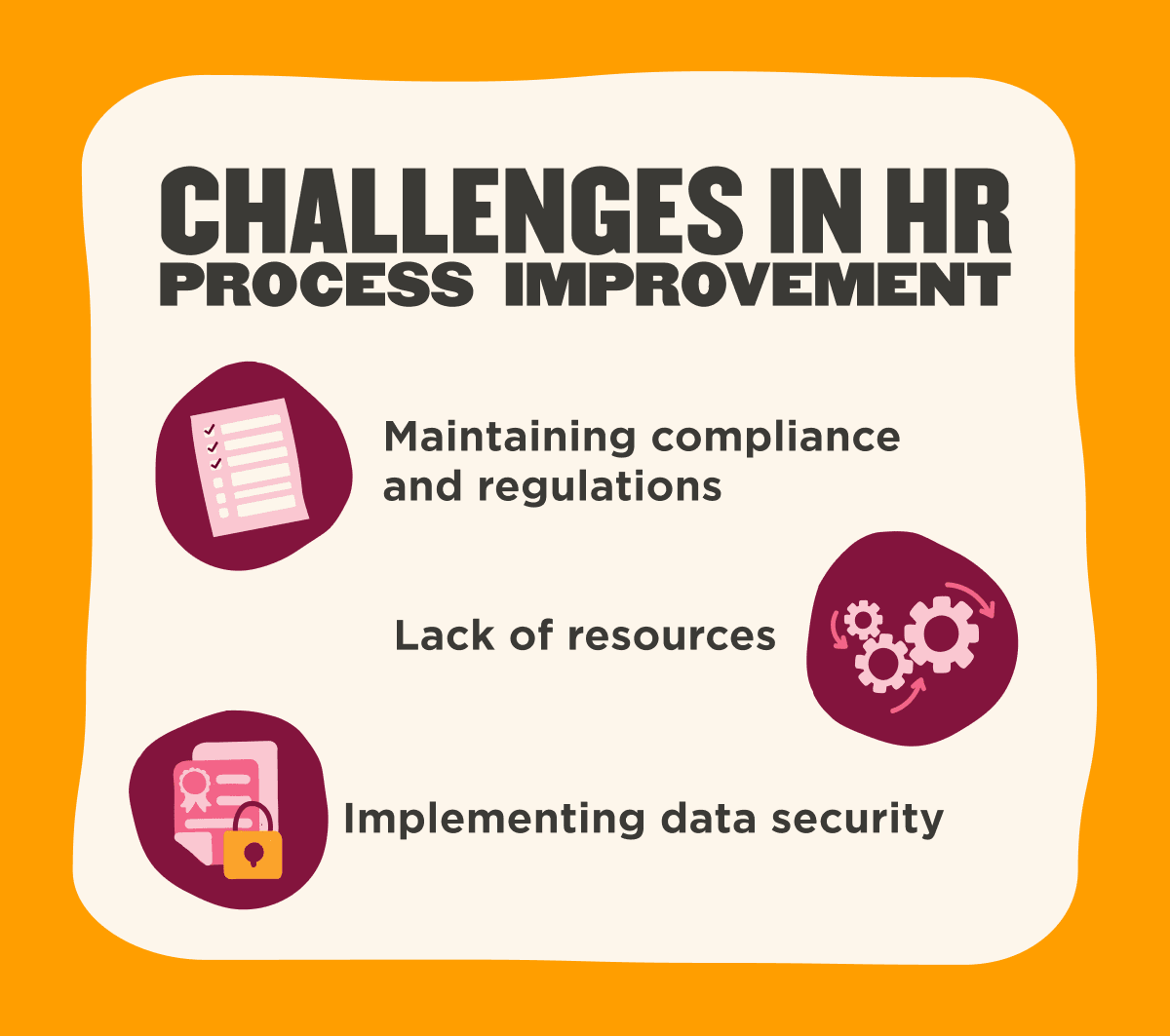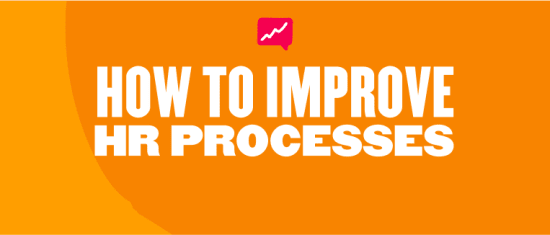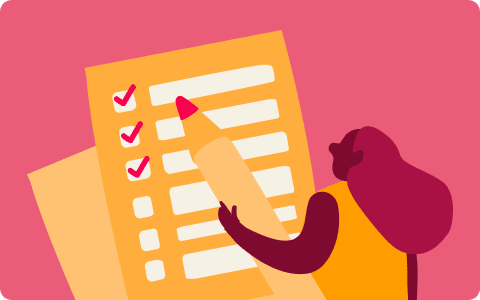When HR processes run smoothly, everything else in your organization works better, too. Clunky, outdated HR workflows drain time, frustrate your people, and keep HR teams stuck in administrative quicksand rather than contributing strategic value.
HR process improvement focuses on optimizing human resources operations to boost productivity, retention, and engagement. Streamlining repetitive tasks through automation, standardizing policies, and incorporating feedback into decision-making, you can transform your HR function from purely administrative to strategic.
<< Evaluate your HR department with this free HR audit checklist. >>
Benefits of prioritizing HR process improvements
The importance of HR processes extends beyond administrative efficiency to creating exceptional employee experiences. When people spend less time navigating complex HR procedures, they can focus more on meaningful work that drives business results. Let’s take a look at some of the key benefits:
Improves alignment between HR and business goals
Companies that successfully align HR strategy with business strategy help drive measurable results across the company, even with limited resources. Continuous process improvement, including refining HR operations, streamlining workflows, and integrating data-driven decision-making, encourages alignment. These efforts enable HR teams to respond faster to business needs and support higher performance, stronger engagement, and better retention.
At Zavida, modernizing HR processes—from onboarding and payroll to performance management—helped align HR strategy with broader business goals. Automating equipment requests, introducing bilingual workflows, and upgrading reviews to include self-assessments empowered HR to support both operational efficiency and employee development.
These improvements freed up time for strategic initiatives, supported Zavida’s expansion into Montreal, and strengthened engagement across their diverse workforce.
Reduces costs
Streamlined HR processes eliminate redundancies, reduce errors, and minimize time spent on manual tasks. This leads to:
- Reduced administrative overhead: HR automation decreases time spent on paperwork and manual data entry, allowing HR teams to accomplish more with fewer resources.
- Fewer compliance penalties: Standardized processes reduce the risk of costly compliance violations that can result in fines and legal expenses
- Improved retention: Efficient HR workflows contribute to better team member experiences, decreasing turnover costs, and reducing turnover rates
At Ualá, automating HR workflows and integrating systems like their ATS with their HR platform significantly reduced manual tasks and administrative overhead. Eliminating duplicate data entry during onboarding led to a 25 percent cost reduction for the payroll team, clearly demonstrating the value of streamlined processes.
These improvements also enhanced the team member experience, supporting higher retention and enabling more efficient scaling during rapid growth.
Mitigates compliance risks
HR compliance is significantly easier when your processes include built-in safeguards and verification steps, especially if you have global teams in different jurisdictions. These systems create audit trails and documentation that protect your organization during regulatory reviews or legal challenges.
For Novatti, improving HR processes through HR software tools played a key role in mitigating compliance risks. With a distributed workforce, they needed accurate, timely reporting to meet obligations across different jurisdictions. Moving away from manual methods allowed them to centralize people data in a secure platform, reduce the risk of human error, ensure consistent documentation, and establish clear audit trails.
These process improvements enabled the team to generate detailed reports for regulatory agencies and their Board more efficiently, while also reinforcing data integrity and supporting gender equity compliance efforts.
<< Stay up to date with this HR compliance checklist. >>

Top strategies for improving HR processes
With these HR process improvement strategies, you can take a comprehensive approach to enhancing efficiency, engagement, and adaptability across your people operations. Start with the strategies that address your most pressing challenges, then consider others as your team builds momentum and confidence.
1. Automate repetitive tasks
As businesses grow, relying on manual processes and memory isn’t just an inefficient way to work—it’s also risky. That’s why choosing a flexible HR tech platform with seamless integrations and built-in workflow capabilities can boost efficiency across the entire organization.
Rely on your tech stack to handle reminders and routine tasks. This approach helps eliminate manual data entry, streamline approvals, and take care of recurring communications that often eat into HR’s time, like follow-ups for incomplete documentation or nudges about upcoming performance reviews.
Companies using HR automation tools see measurable gains in accuracy, compliance, and team productivity. Automating repetitive tasks frees up HR professionals to focus on strategic initiatives that enhance people’s experience and create a positive company culture.
Potential HR processes to automate include:
- Onboarding processes
- Time-off requests and approvals
- Performance review cycles
- Payroll data syncing
- Contract and policy acknowledgments
- Internal communications (e.g., reminders and confirmations)
- Document management and e-signatures
- Training enrollment and compliance tracking
Airtasker, an online marketplace, leveraged HR tech to transform its HR processes by automating repetitive tasks and creating a streamlined experience for both HR teams and new hires. Previously, manual tasks like onboarding, data entry, and managing milestones across disconnected tools demanded significant administrative time. Introducing an HR platform allowed them to replace manual workflows with automated onboarding processes, allowing HR professionals to send out communications, set up meetings, and track progress in just a fraction of the time.
The automation of people-related tasks—from celebrating milestones to generating financial and demographic reports—means that teams spend less time on repetitive admin and more time focusing on strategic projects, ultimately elevating the overall employee experience and strengthening company culture.
2. Centralize employee data
Maintaining a single source of truth for all employee information improves accuracy, accessibility, and reporting capabilities. Complete HR systems that centralize data enable better decision-making across departments by providing real-time access to accurate information. This centralization also enhances security by reducing the number of systems containing sensitive team member data.
To put this into action:
- Consolidate all team member records, documents, and communications into a unified HR platform
- Ensure all departments—from finance to IT—use the same system to avoid duplicate records or miscommunication
- Set permissions based on roles to protect confidential information while keeping key stakeholders informed
- Regularly audit data entries to maintain quality and resolve inconsistencies early
At Geminor, streamlining HR operations through a unified platform enabled the company to consolidate people data across nine countries into a single, reliable source. This shift eliminated fragmented local systems, reduced duplication, and gave leaders immediate access to accurate, real-time data.
With centralized records, Geminor improved cross-department collaboration and safeguarded sensitive information through role-based access, laying the foundation for more strategic decision-making and scalable growth.
3. Improve communication channels
Establishing clear communication protocols ensures information flows efficiently between HR, leadership, and team members. This reduces confusion, prevents policy misinterpretations, and builds trust throughout the organization.
Build a communication ecosystem that supports transparency and autonomy by:
- Standardizing notification methods: Create consistent communication patterns for different types of HR information, such as policy updates, benefit changes, or procedural modifications
- Creating self-service resources: Empower people to find information independently through knowledge bases, FAQs, and digital resource libraries
- Implementing feedback loops: Gather input on process effectiveness through regular surveys, focus groups, and one-on-one meetings
At Distrelec, modernizing HR through a centralized platform transformed the way information flows across 14 European sites. Standardized communications, targeted announcements, and localized content made it easier for teams to understand policies and access resources independently. These improvements strengthened trust, reduced confusion, and empowered remote teams to stay connected and engaged across locations.

4. Use analytics to make decisions
Data-driven insights help HR teams identify bottlenecks, measure process effectiveness, and prioritize improvements. Organizations that leverage HR analytics make decisions faster and are more likely to implement successful process improvements.
HR dashboards that track key metrics for different HR processes provide visibility into what’s working and what needs attention. These insights allow you to allocate resources to the highest-impact improvement opportunities rather than making changes based on assumptions.
At SmartRecruiters, streamlining HR through a centralized platform enabled the team to leverage real-time analytics for faster, more effective decision-making. With dashboards tracking key metrics like headcount, turnover, and salary data, HR can respond to departmental requests quickly and prioritize improvements based on evidence, not guesswork.
This data-driven approach has elevated HR’s role across the company and helped ensure resources are directed where they make the biggest impact.
5. Focus on employee engagement
Engagement-focused process improvements like simplifying performance reviews or implementing recognition programs can help increase satisfaction and morale. You can help boost engagement with:
- User-friendly benefits enrollment processes that help people maximize their options
- Opportunities for continuous learning through curated development paths and access to training resources
- Internal mobility frameworks that make career growth visible and accessible
- Engagement check-ins to regularly gather feedback and act on it quickly
At AlgoSec, improving HR processes has played a central role in strengthening employee engagement across their global workforce. Using regular surveys, the HR team gathers actionable feedback and collaborates with managers to develop targeted initiatives, like launching an internal learning program in response to employee requests for more training.
These engagement-focused improvements have helped AlgoSec foster a culture of listening, transparency, and continuous development, driving up satisfaction scores year after year.
6. Standardize company policies
Consistent company policies help ensure fair treatment and reduce confusion across your organization. When different managers or departments apply policies differently, they may create perceptions of favoritism and undermine team trust.
Documenting policies and making them easily accessible through digital platforms ensures everyone operates from the same playbook. Start by standardizing high-impact policies for topics like paid time off (PTO), performance management, and compensation to establish a foundation for consistency.
Build on this framework by aligning departmental practices, offering training for people managers, and regularly reviewing policies to reflect your evolving culture and values. Standardization doesn’t mean rigidity—it means clarity. When everyone knows what to expect and how to act, it’s easier to build a fair, transparent, and people-first workplace.
At Australian Wool Innovation, streamlining HR processes through a flexible platform enabled the organization to standardize key policies across its 12-country workforce. With consistent, localized time-off rules and a customized performance review process built into the platform, every team member now follows the same guidelines, regardless of their location.
This standardization has reduced confusion, ensured fair treatment, and aligned local practices with AWI’s global culture and values, fostering a more unified and transparent workplace.
7. Create a culture of feedback
Regular feedback mechanisms help identify process pain points and improvement opportunities that might not always be visible to HR teams. Try implementing:
- Process improvement workshops: Facilitate collaborative problem-solving sessions that bring together diverse stakeholders to redesign problematic processes
- Regular pulse surveys: Gather quick insights on process effectiveness through short, focused questionnaires distributed at strategic intervals
- Recognition for suggestions: Encourage ongoing participation by acknowledging and rewarding team members who contribute valuable process improvement ideas
Defined.ai has built a strong culture of feedback by embedding regular check-ins and engagement surveys into its remote-first work model. Through biannual engagement surveys and quick pulse checks, HR gathers ongoing insights into how people feel about company initiatives and workplace experiences.
This continuous feedback loop not only uncovers hidden pain points but also drives collaborative improvements, helping employees feel heard, valued, and involved in shaping company culture.
8. Align HR goals with business objectives
Creating HR OKRs that connect directly to business objectives is a powerful way to demonstrate the strategic value of people initiatives. This alignment helps secure support and resources by clearly showing how HR drives organizational success.
To track meaningful progress, convert company goals—like revenue growth or customer satisfaction—into trackable HR KPIs. For example:
- Reduce time-to-hire and boost internal mobility to increase operational agility
- Lower turnover and raise engagement scores to strengthen culture and retention
- Increase productivity per team member and maximize training ROI to drive business performance
- Improve onboarding effectiveness and expand customer-facing training to elevate customer experience
- Close skill gaps, expand learning participation, and strengthen succession coverage to build future readiness
When HR metrics align with company outcomes, it’s easier to focus efforts, demonstrate value, and make informed decisions about where to invest next. This strategic clarity helps HR lead with impact and intention.

9. Implement self-service options
Employee self-service tools reduce administrative burden on HR teams while improving team member satisfaction. Modern workers expect the same digital convenience in workplace processes that they experience as consumers.
Self-service options that deliver the most value include:
- Personal information updates
- Time-off requests and approvals
- Benefits enrollment and changes
- Access to pay statements and tax documents
- Learning and development resources
At Save the Children Italia, adopting self-service functionality through their HR platform has eased the administrative load on HR and payroll teams while empowering employees. Team members can now independently update personal details, ensuring information stays current and accurate without constant HR intervention. This shift has improved efficiency and given employees greater control over their own data, bringing modern convenience to their everyday workplace experience.
10. Streamline approval workflows
To maintain oversight without adding friction, build approval triggers into the system for tasks that carry financial or compliance implications. This strikes the right balance between empowerment and accountability.
You can also simplify how your organization makes decisions. Long, multi-step approval chains reduce momentum and often add little value. Set approval paths based on the type of action, its risk, and financial impact, not on titles or hierarchy.
Move faster by involving only the stakeholders who are truly essential. When teams streamline expense approvals, hiring decisions, and policy updates, they reduce delays and gain the clarity they need to act with confidence.
Using HR tech, adventure booking platform TourRadar streamlined workflows for onboarding, compensation reviews, and time-off tracking. As a result, their People team no longer had to spend time chasing down paperwork or managing approvals manually.
Following the performance cycles, TourRadar runs an annual compensation review cycle. They then automate the compensation approval process across relevant stakeholders—a seamless process that replaced the Excel spreadsheets they used before.
This freed up their HR department to focus on strategic projects that drive engagement and support a transparent, compliant workplace.
11. Digitize documentation
Shifting from paper to digital documents enhances accessibility, boosts security, and eliminates the need for physical storage. Key items—like employment contracts, policy acknowledgments, performance reviews, and compliance certifications—become easier to manage and retrieve when stored digitally.
Using digital signature tools and document management systems also helps maintain version control and creates reliable audit trails, supporting both transparency and compliance.
At Rebellion, moving from paper-based to fully digital HR processes has significantly improved how they manage documentation. Employment forms, onboarding materials, and policy communications are now handled through HR software, reducing manual work and removing the need for physical storage. This digital shift has enhanced accessibility, streamlined compliance, and ensured that important documents are easy to track, manage, and audit.
Best practices for HR process improvement
These best practices apply regardless of which specific processes you’re optimizing. They create the foundation for successful implementation and sustainable results.
1. Involve different department stakeholders
Engaging stakeholders from across the organization improves process design and increases adoption. When people participate in creating solutions, they develop ownership and commitment that drives successful implementation.
Include them through:
- Early consultations: Involve stakeholders in the planning stage to gather diverse perspectives and identify potential obstacles before they become problems
- Regular updates: Keep stakeholders informed of progress through brief, targeted communications that highlight achievements and upcoming changes
- Feedback channels: Gather ongoing input from process users through multiple channels to capture insights at different stages of implementation
2. Communicate changes clearly
During moments of change—whether it’s a new leadership structure, policy updates, or shifts in workforce strategy—clear, transparent communication helps reduce uncertainty, build trust, and increase adoption of new processes.
Almost three-quarters of HR leaders say their employees are experiencing change fatigue. This can lead to both active pushback and passive hesitation, ultimately affecting the progress of improvement efforts. However, people are more likely to embrace change when they understand the “why” behind it and how it affects them.
Tailor your communication strategy to match the scale and context of the change. Major transformations call for structured plans with consistent touchpoints, while smaller updates may only need a focused message to those impacted. When teams feel informed and supported, they’re more confident navigating what’s next.
3. Stay up to date with current HR trends
HR practices are evolving rapidly due to technological advances, changing workforce expectations, and new regulatory requirements. Awareness of industry developments helps you implement forward-looking process improvements rather than simply fixing yesterday’s problems.
Reliable sources for HR trend information include industry research reports, professional associations, and peer networks. Evaluate which trends are relevant to your specific organizational context rather than chasing every new idea, focusing on those that align with your strategic priorities.
Making informed HR decisions requires a balance of innovation and practicality. The most successful organizations adopt emerging practices selectively, prioritizing those with the strongest evidence of effectiveness for their industry, location, and size.
4. Test new policies on small groups
Piloting changes with a limited audience allows for refinement before full implementation, reducing risk and increasing success rates. Even well-designed processes often need adjustments when they encounter real-world conditions.
Select pilot groups that represent the diversity of your organization while being small enough to manage effectively. Gather meaningful feedback through structured evaluations and informal conversations, then use these insights to refine the process before wider rollout.
5. Monitor and review new processes
Ongoing measurement prevents processes from drifting away from their intended design. Establish key metrics such as completion time, error rates, user satisfaction, and business impact. Regular reviews highlight processes requiring adjustments due to changing business conditions, technological advancements, or regulatory updates. Base these adjustments on data-driven insights rather than anecdotal feedback.
Treat process improvement as continuous, ensuring your HR operations evolve alongside organizational growth. Processes working seamlessly today may become bottlenecks tomorrow. Establish frameworks for periodic evaluation, like quarterly metric reviews and annual assessments, prioritizing refinements by impact and feasibility.
Finally, equip your HR team with skills in lean management, design thinking, and change management, turning team members into effective process architects and driving sustained optimization.

Common challenges in HR process improvement
Every HR team aims to enhance processes and drive better outcomes for people and organizations. However, improvement efforts can face hurdles—some predictable, others unexpected. Understanding common challenges ahead of time empowers teams to build robust strategies and drive meaningful change. Here’s what to watch for and how to prepare for success.
Maintaining compliance and regulations
Regulatory requirements can complicate process improvements by adding constraints and documentation needs. Balancing efficiency with compliance requires careful design that incorporates legal requirements without creating unnecessary bureaucracy.
Automated compliance tracking supports both objectives by ensuring regulatory adherence while minimizing manual effort. These systems can flag potential issues, maintain required documentation, and adapt to changing regulations without disrupting core processes.
Lack of resources
Resource constraints can limit improvement initiatives, particularly in smaller organizations where HR teams already manage multiple responsibilities. Strategic prioritization helps teams make progress despite limited resources by focusing on high-impact changes.
Building a business case for additional resources is easier when you can demonstrate early wins from initial improvements. Start with changes that require minimal investment but deliver visible results, then use these successes to secure support for more ambitious initiatives.
Implementing data security
Process improvements, especially those involving sensitive team member data, require comprehensive security measures. The average cost of a data breach is substantial, making security a critical aspect of process design.
Security best practices for HR processes include role-based access controls, encryption for sensitive data, audit trails for all transactions, and regular security assessments. Balance accessibility with appropriate protections by applying security measures proportional to data sensitivity.
Drive meaningful change with better HR processes
Improved HR processes position your team as strategic partners in organizational success by freeing resources from administrative tasks and providing data-driven insights. The strategies outlined in this guide create a roadmap for transforming your HR function from reactive to proactive.
As you implement these improvements, remember that the goal isn’t perfection but progress. Each refinement builds momentum toward more efficient, effective HR operations that better serve your people and your business objectives.
<< Determine the ROI of your HR improvements with this free workbook. >>
FAQs about HR process improvement
How do I identify which HR processes to improve first?
Begin by pinpointing the processes that are visibly causing the most significant friction points within the organization. Consider which procedures are consuming disproportionate amounts of time for both HR staff and other team members. Most importantly, focus on processes that have a substantial influence on the overall team member experience.
What metrics should I use to measure HR process improvement success?
Track both operational efficiency and team member experience to get a complete view. Key metrics include:
- Processing time for tasks like onboarding or approvals
- Error rates in documentation or data handling
- Satisfaction scores from surveys and feedback
- Number of non-compliance incidents before and after changes
Establish baselines before implementing changes so you can clearly measure progress and make informed adjustments.
How often should you review HR processes?
HR processes thrive when they evolve in step with the organization. A quarterly review of critical, high-impact processes—those tied to daily operations or compliance—keeps teams agile and responsive to changing needs.
At the same time, a comprehensive annual audit provides space to evaluate the broader strategy, identify systemic gaps, and plan long-term improvements. This approach balances responsiveness with strategic foresight, building a culture of continuous improvement and keeping HR efforts aligned, effective, and people-centered.
Recommended For Further Reading
Can small HR teams improve processes with limited resources?
Absolutely. Even with limited bandwidth, small HR teams can make a big impact by being strategic and focused. Start by targeting the processes that deliver the greatest return—those that streamline work, reduce friction, or enhance the team member experience. Lean into technology to automate manual tasks and simplify workflows, using available tools that fit your budget.
Clear process mapping helps ensure every improvement is purposeful and measurable. With the right priorities and smart use of resources, small teams can lead meaningful change across the organization.
How do I get leadership buy-in for HR process improvement initiatives?
Connect your initiatives to broader business outcomes. Leadership is more likely to support changes that:
- Boost profitability or reduce costs
- Improve retention and satisfaction
- Support customer success or operational efficiency
Present data-backed insights and highlight ROI—think time saved, engagement gains, or improved compliance. A clear, strategic business case goes a long way in securing support.


